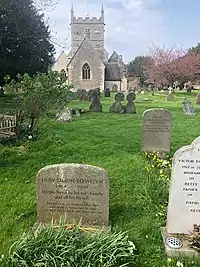Church of All Hallows, South Cerney
The Church of All Hallows is an Anglican parish church in the village of South Cerney, Gloucestershire. The church is of Norman origins, with medieval alterations and a major restoration in the 19th century. A Grade I listed building, it remains an active parish church.
| Church of All Hallows, South Cerney | |
|---|---|
| Church of All Hallows | |
 The church from the churchyard | |
 Church of All Hallows, South Cerney Location in Gloucestershire | |
| Location | South Cerney, Gloucestershire |
| Country | England |
| Denomination | Church of England |
| History | |
| Status | Parish church |
| Founded | C13th-C14th century |
| Architecture | |
| Functional status | Active |
| Heritage designation | Grade I |
| Designated | 26 November 1958 |
| Architectural type | Church |
| Administration | |
| Parish | South Cerney |
| Diocese | Gloucester |
| Clergy | |
| Vicar(s) | The Revd Jennifer Mary McKenzie |
History
The origin of the church is Norman, when the benefice was in the possession of Gloucester Abbey.[1] It was repeatedly altered in the medieval period. The spire on the tower was destroyed by lightning in 1857 and never reconstructed.[1] The church was thoroughly restored by James Piers St Aubyn in 1862.[2] All Hallows is an active parish church serving the parishes of South Cerney and Cerney Wick.[3]
An archaeological investigation in the churchyard in 1999 discovered a number of medieval burial pits, which appeared to have been reconstructed in the 19th century rebuilding.[4]
Architecture and Description
The church consists of a central tower, without its original spire, a nave and South aisle, and a chancel of 14th century origin.[1] The porch is a 19th-century addition.[5] The "very elaborate" doorway is Norman, although moved to its present position by St Aubyn.[1] Pevsner records the similarities to that in the church at Mesland near Blois in France.[1] The interior contains a number of important wall monuments in marble, dating from the 18th and 19th centuries.[5] The church is a Grade I listed building.[2]
The South Cerney Christ
In 1912, two fragments, a head and a foot, from a large figure of Christ were discovered in a wall cavity in the nave. The Christ, of medieval date, is likely to have been concealed during the Reformation but its history is largely unknown.[6] The two pieces were sold by the church and purchased by the British Museum,[7] with the aid of a grant from the Art Fund.[8] Replicas are displayed in the church.[6]
References
- Verey & Brooks 2000, pp. 617–618.
- England, Historic. "CHURCH OF ALL HALLOWS, South Cerney – 1340977- Historic England". historicengland.org.uk.
- Churches, Churnside. "Churnside Churches – South Cerney". www.churnsidechurches.org.uk.
- "All Hallows Church, South Cerney – Reports Archive". Reports.cotswoldarchaeology.co.uk. Retrieved 2018-05-19.
- England, Historic. "CHURCH OF ALL HALLOWS, South Cerney – 1340977- Historic England". historicengland.org.uk.
- Trust, South Cerney. "South Cerney Trust – Head and Foot". www.southcerneytrust.org.uk.
- "The South Cerney Head". British Museum.
- Fund, Art. "Two fragments of a crucifix by Unknown Artist".
Sources
- Verey, David; Brooks, Alan (2000). Gloucestershire 1: The Cotswolds. The Buildings of England. New Haven, US and London: Yale University Press. ISBN 9780300097337.